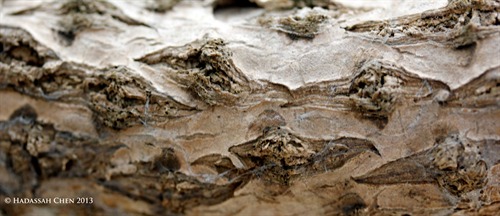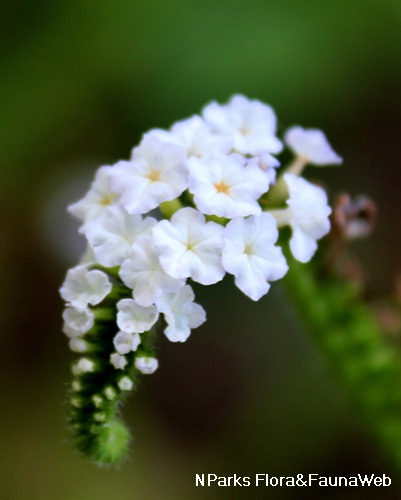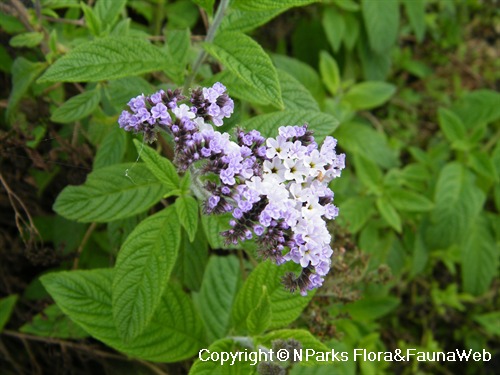
Back
Heliotropium arboreum (Blanco) Mabb.
| Family Name: | Boraginaceae |
| Synonyms: | Tournefortia argentea L.f. |
| Common Name: | Tree Heliotrope |
Name
Classifications and Characteristics
| Plant Growth Form | Tree (Small (6m-15m)) |
|---|
Biogeography
| Native Distribution | Southern China, Japan, Vietnam, Philippines, Sri Lanka, Madagascar, Northern Australia, Polynesia, Micronesia and Melanesia. |
|---|---|
| Native Habitat | Shoreline |
| Preferred Climate Zone | Tropical, Sub-Tropical / Monsoonal |
Description and Ethnobotany
| Growth Form | Slow growing tree to 6m tall, rarely to 12m. |
|---|---|
| Foliage | Leaves oblanceolate to obovate, silvery green, pubescent, 10-30cm long by 3-12cm wide. |
| Flowers | Inflorescence in paniculate or scorpoid cymes. Flowers white, to 0.5- 0.6cm across, pubescent. |
| Fruit | Fruits 0.5-0.8cm across, ripening greenish orange |
| Ethnobotanical Uses | Edible Plant Parts : Edible Leaves Food (Herb or Spice): The leaves supposedly taste like parsley and are eaten raw (as a salad) by Pacific islanders. They also use the leaf as a cooking spice, as a stuffing for Medicinal: In the Pacific islands, the inner bark of the root is used to treat diarrhoea, poisoning due to consumption of tainted fish, and rashes in children. The leaves are also used as a medicinal tea, and also in steam baths for women after delivery. An extract of the roots is also taken as a treatment for rheumatism. Timber & Products: The wood is used in house building and making of canoes in some of the Pacific Islands. It is also used extensively as firewood, and also to make smaller objects such as handles for tools, as well as handicraft. Agriculture - Forestry: It is used as a windbreak and salt spray barrier, and is often cultivated as a street/ park tree in areas near the coast. Cut - Dried Flower: The flowers and fruits are used in traditional garlands (leis) Cultural / Religious: The wood and leaves are believed to have magical properties. In Namoluk island, the young unopened leaves are used in a spell to rid a person from 'sea spirits', and the woody material (near the ground) is used to treat diseases supposedly caused by the violation of certain taboos concerning with the sea. Others: The leaves are used in the preparation of a red dye. |
Landscaping Features
| Desirable Plant Features | Ornamental Flowers, Ornamental Foliage, Ornamental Form |
|---|---|
| Landscape Uses | Parks & Gardens, Coastal, Beachfront / Shoreline |
| Thematic Landscaping | Silver Garden |
Fauna, Pollination and Dispersal
| Fauna Pollination Dispersal Associated Fauna | Butterfly-Attracting (Flower Nectar) |
|---|---|
| Pollination Method(s) | Biotic (Fauna) |
Plant Care and Propagation
| Light Preference | Full Sun |
|---|---|
| Water Preference | Moderate Water, Little Water |
| Plant Growth Rate | Moderate |
| Rootzone Tolerance | Drought Tolerant, Well-Drained Soils, Shallow Media |
| Planting Remarks | This species should be grown in very well drained soils as root rot can set in if soil drainage is poor. It is able to take sandy soils and can be grown next to the shoreline as it can tolerate seawater inundation. It is also wind resistant. |
| Pruning | Can be pruned back periodically to control their size. However, it does not tolerate extensive pruning. As it has a rather broad, spreading form, it is best to grow this species in coastal parks and gardens. |
| Propagation Method | Seed, Stem Cutting, Marcotting |
Foliar
| Foliage Retention | Evergreen |
|---|---|
| Mature Foliage Colour(s) | Green, Silver / Grey |
| Mature Foliage Texture(s) | Velvety / Furry / Tomentose |
Floral (Angiosperm)
| Flower Colour(s) | White |
|---|---|
| Flower Grouping | Cluster / Inflorescence |
Fruit, Seed and Spore
| Mature Fruit Colour(s) | Green, Orange |
|---|
Image Repository
Others
| Master ID | 31700 |
|---|---|
| Species ID | 6099 |
| Flora Disclaimer | The information in this website has been compiled from reliable sources, such as reference works on medicinal plants. It is not a substitute for medical advice or treatment and NParks does not purport to provide any medical advice. Readers should always consult his/her physician before using or consuming a plant for medicinal purposes. |




